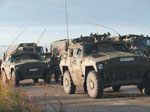Advanced Network Aids New NATO State
 |
| The Slovak army’s mobile military communications system (MOKYS) will link warfighters across all echelons. Mobile command posts will use high-data-rate digital radios to connect small tactical units with national headquarters. |
The mobile military communications system (MOKYS) consists of handheld and manpack radios linked to mobile command posts. The vehicle-based systems will use line-of-sight and radio relays to connect with strategic-level networks. “It [MOKYS] provides the flow of information from the MOD [Ministry of Defense] down to the soldier as well as horizontal communications between brigade and battalion command posts,” says Daniel Quinn, MOKYS program manager, BAE Systems, Green Lawn,
MOKYS includes a variety of equipment ranging from legacy low-bandwidth voice communications systems to advanced programmable radios providing data and voice capabilities. The software-based radios will form a gateway to the wideband communications networks connecting command posts. The system’s Internet protocol (IP) infrastructure uses a combination of military and commercial technologies designed to meet the Slovak government’s current and future needs.
Slovak army command posts will use Ericsson line-of-sight equipment to link with national strategic communications networks. Quinn notes that MOKYS also will give the military the mobility and flexibility to support coalition forces during international deployments because it meets NATO interoperability standards.
The handheld and manportable equipment is based on the Rhode and Schwarz M3TR family of software programmable radios. The M3TR radios also have an IP interface that allows them to link with the command post systems comprising BAE Systems wideband programmable networking radios. Quinn says that the BAE Systems radios can form a wireless local area network extension with a 10-megabit transmission data rate, providing the command post with networking capability and mobility. “Typically, command posts are statically placed and connected via line-of-sight. This radio gives them full IP routing capability as an outgrowth of networking radios that we developed in the
The high-bandwidth links provided by the command post radios allow the army to use battlefield video and imagery applications. BAE Systems also can provide modular interfaces permitting command post radios to link at the router level with legacy Eurocom systems as well as with IP, asynchronous transfer mode and integrated services digital network systems.
Because the system is so novel, Quinn claims that it is the most sophisticated of its kind in
Quinn explains that the C4 capability is an outgrowth of smaller BAE Systems programs across
The MOKYS program began in May 2005 when the Slovak government initiated an international contract for a new mobile communications system. Quinn explains that the program was a move by the Slovak government to meet its NATO force requirements. In the tender, the government sought international firms experienced in providing communications and information systems. “They were really looking for a large system integrator to perform these requirements for them,” Quinn says.
 |
| The new MOKYS system will provide the Slovak army with state-of-the-art communications equipment and networks that are fully interoperable with NATO and U.S. systems. |
Another aspect of the winning equation derived from including local Slovak firms in the program. Quinn estimates that local firms are doing about 30 percent of the work. “We took advantage of the expertise in country—those firms that were familiar with the local equipment as well as the military inventory and the vehicle installation capability—and applied that to the international team,” he explains.
The MOKYS program is scheduled to span nine years. It is currently in its design phase, which will be followed by prototype construction and serial production over the next eight years. The project will outfit the entire Slovak army and will provide an interface with the air force. Quinn notes that the BAE Systems wideband radio can serve as a gateway to communicate with airborne platforms.
The program is valued at from $150 million to $200 million, and it is the largest contract ever awarded by the Slovak government. “From a
Quinn adds that
O’Kelly also sees the program as setting a commercial example for many nations in the region. “Involving local industry to the extent that we have and deconstructing the requirement so that it is the best fit for that particular customer are fairly novel approaches for some of these countries. In the past I think there’s been a tendency where they’ve been oversold a capability, rather than getting something that fits their requirement exactly but still gives them room to expand in the future,” he says.
Web Resources
Slovak Ministry of Defense: www.mosr.sk/index.php?page=64
BAE Systems: www.baesystems.com




Comments